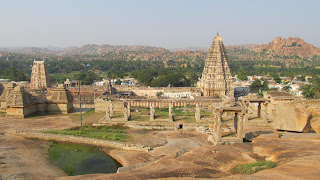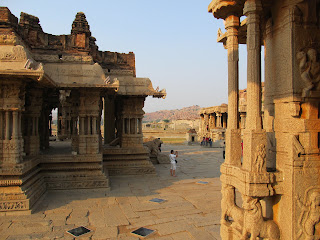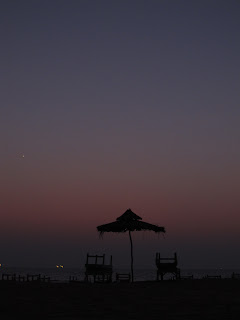More specifically Fort Kochi. Kochi, an ancient port town, encompasses quite a diverse spread of towns and cities sprawling for miles across islands and peninsulas, within that there is Fort Kochi and Mattancherry. Initially, when arriving in the quaint streets, the old Portuguese houses bowing out onto the quiet roads, immaculately presented offering arts, crafts, pots of tea and homestays, I felt a little irritated by the contrived nature of it all. It is clean, quiet, pretty, and extremely un-Indian, so un-indian in fact that the only Indians that can be seen are the ones ferrying Whities around in their blinged up rickshaws, and behind shop counters. I haven’t seen such a high ratio Westerners to Indians since I left the UK, even in Goa, there were as many Indians as there were Whites. I could be in Portugal. This is a destination for a two week, chilled out, holiday from work. A place to kick back and relax, take in the heat, a bit of colonial history, and peruse endless arts and crafts shops sifting through little bits of Indian history, rounding the day off with a freshly scented cup of green mango tea and a slice of chocolate cake. Along the sea front (which, with its dockland horizon, reminds me a little of a sweaty Southampton) there are timber framed Chinese fishing nets that bow gracefully into the sea to capture fish and seafood. When the sun goes down, their silhouettes jut benignly from the shoreline in front of a sinking pink sphere. Walking around the streets, into the richer neighbourhoods, there is a feeling of space and peace. There are lots of green spaces and parks, with huge hairy trees and banyan trees lining the roadsides. The colours are greens and yellows. The horns are silenced. The people move slower, and smile more. And as contrived it initially appears, I would recommend this place for a two week holiday without any hesitation.

 On walking around a little outside the main tourist streets, the real feel of the place becomes apparent. It is a little moment of calm in this vast frenetic country. The tourist streets only take up a small area, and exploring beyond them the roads weave into little centres of commerce where spices, plastics, cooking pots, and many other wares are traded in bulk through secretive looking doors, Arabic in their design. A stroll through the outskirts of Fort Kochi, shows the huge influence the traders of past eras have had on the area. Its architecture is truly multicultural, with buildings boasting Chinese style roofs, atop colonial walls, to be entered through solid looking Persian doors, built next door to synagogues. These streets make history present, the past is crystallised in the day to day trading. Even in the more modern streets, there are less cars, less people, less bustle and less noise. The old sits happily with the new, rather than being obscured by it as it seems to be in the other places we have visited (aside from Panaji). All the buildings are low rise, so the sun streams onto the streets unhindered making the place seem bright and lively. And the white people disappear. It is incredible, one only has to walk 500m away from the few roads that have been put on show for the tourists and they completely disappear. I wonder if there is a large invisible Chinese fishing net just over these roads that hold all the whites in one place, and it is only a few stray wigglers that manage to free themselves to go and look around the place where the Indians live. And we like where the Indians live, hence we have decided to stay for a while. I have even bought myself some Indian clothes, which are currently at the tailors being assembled. And no, it is not a sari. All the women in India, apart from in the really big cities, wear the same style clothes, either the sari, or a tunic, trousers and scarf combination (which I have opted for). The lack of styling variety sounds a little dull, but the immense array of colours and patterns, mean that no two women are dressed the same and their fashion means that wherever there are women, the place is vibrant and sparkly.
On walking around a little outside the main tourist streets, the real feel of the place becomes apparent. It is a little moment of calm in this vast frenetic country. The tourist streets only take up a small area, and exploring beyond them the roads weave into little centres of commerce where spices, plastics, cooking pots, and many other wares are traded in bulk through secretive looking doors, Arabic in their design. A stroll through the outskirts of Fort Kochi, shows the huge influence the traders of past eras have had on the area. Its architecture is truly multicultural, with buildings boasting Chinese style roofs, atop colonial walls, to be entered through solid looking Persian doors, built next door to synagogues. These streets make history present, the past is crystallised in the day to day trading. Even in the more modern streets, there are less cars, less people, less bustle and less noise. The old sits happily with the new, rather than being obscured by it as it seems to be in the other places we have visited (aside from Panaji). All the buildings are low rise, so the sun streams onto the streets unhindered making the place seem bright and lively. And the white people disappear. It is incredible, one only has to walk 500m away from the few roads that have been put on show for the tourists and they completely disappear. I wonder if there is a large invisible Chinese fishing net just over these roads that hold all the whites in one place, and it is only a few stray wigglers that manage to free themselves to go and look around the place where the Indians live. And we like where the Indians live, hence we have decided to stay for a while. I have even bought myself some Indian clothes, which are currently at the tailors being assembled. And no, it is not a sari. All the women in India, apart from in the really big cities, wear the same style clothes, either the sari, or a tunic, trousers and scarf combination (which I have opted for). The lack of styling variety sounds a little dull, but the immense array of colours and patterns, mean that no two women are dressed the same and their fashion means that wherever there are women, the place is vibrant and sparkly.
We have found an apartment to rent on the outskirts of Fort Kochi, just far enough away from all the tourism to not even know it is there if we like. It has two bedrooms, three bathrooms, a kitchen, living area, balcony and roof terrace. Amazing! So anyone who wants to come and visit, we have somewhere for you to stay. We are moving in this weekend, and are employing a rickshaw driver, Edwin, to show us where we can buy good local produce to cook for ourselves and some popular local restaurants. That is the only really bad thing about the tourist places here, the food is terrible, really terrible. We have had to search really hard to find something good, and hopefully our local guide will be able to help us find where the Indians hang out.
 Another wonderful thing about staying here is its location (another reason for you to come and stay with us!). We are no longer than 4 hours away from some beautiful places. There are the hill stations, wildlife sanctuaries, waterfalls, beaches and the backwaters, all just a few hours away to go and explore. I have already taken a bus to the backwaters, which, a newly made friend described very aptly as a ‘hot Norfolk Broads’. It is a series of tranquil waterways fringed by stumpy palm trees and the surfaces laced with beautiful, but suffocating African water lilies. There is a constant stream of large wicker clad houseboats cruising along with chunky air conditioning units and generators hanging off their rear side, and little canoes with a crouched down man meditatively lapping the water either side with his paddle, propelling himself serenely. Some of the waterways have been artificially manipulated to incorporate paddy fields, and there are little muddy islands accommodating a few homes, the owners washing themselves in their “outer-underwear” in their natural bathtub. It is one of those places so beautiful that the rush of people to go and see it has taken away its essence a little. We are slowly inching into the tourist season now, and already the waterways are busy with traffic, give it a couple of weeks and I think it will be gridlocked (would that be waterlogged?).
Another wonderful thing about staying here is its location (another reason for you to come and stay with us!). We are no longer than 4 hours away from some beautiful places. There are the hill stations, wildlife sanctuaries, waterfalls, beaches and the backwaters, all just a few hours away to go and explore. I have already taken a bus to the backwaters, which, a newly made friend described very aptly as a ‘hot Norfolk Broads’. It is a series of tranquil waterways fringed by stumpy palm trees and the surfaces laced with beautiful, but suffocating African water lilies. There is a constant stream of large wicker clad houseboats cruising along with chunky air conditioning units and generators hanging off their rear side, and little canoes with a crouched down man meditatively lapping the water either side with his paddle, propelling himself serenely. Some of the waterways have been artificially manipulated to incorporate paddy fields, and there are little muddy islands accommodating a few homes, the owners washing themselves in their “outer-underwear” in their natural bathtub. It is one of those places so beautiful that the rush of people to go and see it has taken away its essence a little. We are slowly inching into the tourist season now, and already the waterways are busy with traffic, give it a couple of weeks and I think it will be gridlocked (would that be waterlogged?).
All in all, Kerala seems to be a pretty relaxed place, with a pace of life that Alex and I can keep up with. I am looking forward to the next month here and want to start absorbing more of the way of life, maybe learn a little Malayalam, enjoy the markets, and make some local friends. I am hoping that things go well enough that we want to stay for 2-3 months……so all the more reason for you to come and stay, we can be your local guides!
p.s. all the cows seem to have been replaced with goats…?































